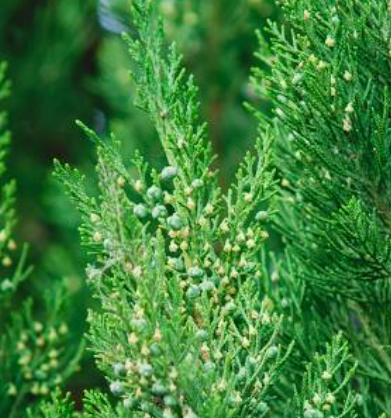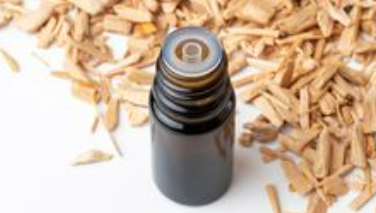Discover Cedarwood Essential Oil

Cedarwood essential oil is derived from the wood of the red cedar tree, also known as Juniperus virginiana. It has a warm, woody aroma and is often used in aromatherapy and natural medicine for its many health benefits. In this article, we will explore the main chemical compounds found in cedarwood essential oil, its health benefits, and how to use it.
Extraction Process of Cedarwood Oil

Cedarwood essential oil is typically extracted from the wood of the cedar tree through a steam distillation process. Here is a brief overview of the extraction process:
- Harvesting: The cedar trees are harvested and the wood is chopped into small pieces.
- Steam distillation: The chopped cedarwood pieces are then placed into a distillation chamber with water. Steam is then introduced into the chamber, which causes the volatile organic compounds in the cedarwood to evaporate.
- Condensation: The steam containing the cedarwood compounds is then cooled and condensed back into a liquid form. This liquid contains the essential oil, as well as water.
- Separation: The essential oil is separated from the water through a process called decantation, which involves allowing the two liquids to settle and then removing the essential oil layer.
- Filtration and bottling: The essential oil is then filtered to remove any impurities and bottled for use.
The entire process of steam distillation can take several hours, and the yield of essential oil can vary depending on the quality of the cedarwood used and the distillation process used. However, steam distillation is considered the most common and effective method for extracting cedarwood essential oil.

Chemical Compounds In Cedarwood Essential Oil
Cedarwood essential oil contains a variety of chemical compounds, including alpha-cedrene, beta-cedrene, cedrol, thujopsene, and widdrol. These compounds are responsible for the many health benefits associated with cedarwood essential oil.
What Are The Health Benefits of Cedarwood Essential Oil?
- Promotes Relaxation and Sleep
Cedarwood essential oil has a calming and soothing effect on the mind and body, making it an excellent natural remedy for promoting relaxation and sleep. It has been shown to help reduce anxiety, improve mood, and enhance sleep quality.
- Supports Respiratory Health
Cedarwood essential oil has antimicrobial and anti-inflammatory properties, making it beneficial for respiratory health. It can help to relieve congestion, coughs, and other respiratory issues.
- Promotes Healthy Skin
Cedarwood essential oil has antiseptic and astringent properties, making it useful for promoting healthy skin. It can help to reduce inflammation, irritation, and redness, as well as improve skin tone and texture.
- Supports Hair and Scalp Health
Cedarwood essential oil has been shown to promote hair growth and improve scalp health. It can help to reduce dandruff, soothe an itchy scalp, and improve hair texture and shine.
What are the best ways to use Cedarwood Essential Oil?
- Aromatherapy
One of the most common ways to use cedarwood essential oil is through aromatherapy. You can add a few drops of the oil to a diffuser or humidifier to help promote relaxation and improve sleep quality.
2. Topical Application
Cedarwood essential oil can be applied topically to the skin to help promote healthy skin and hair. To use it, dilute a few drops of the oil in a carrier oil such as coconut oil or jojoba oil, and apply it to the skin or scalp.
3. Inhalation
Cedarwood essential oil can be inhaled directly from the bottle or added to a bowl of hot water for inhalation. This method can help to relieve respiratory issues such as congestion and coughs.

What does Cedarwood smell like?
The smell of cedarwood essential oil is warm, woody, and earthy, with a hint of sweetness. It has a rich and grounding aroma that is often described as comforting and soothing. The scent is similar to the smell of cedarwood itself, with a slightly stronger and more concentrated aroma. Overall, the aroma of cedarwood essential oil is often associated with feelings of relaxation, calmness, and tranquility.
What other essential oils does Cedarwood Essential Oil blend well with?
Cedarwood essential oil blends well with a variety of other essential oils, including:
- Lavender oil: Cedarwood and lavender oil complement each other well, creating a relaxing and calming blend.
- Bergamot oil: When blended with cedarwood, bergamot oil can help to create an uplifting and energizing aroma.
- Patchouli oil: Patchouli and cedarwood create a grounding and earthy aroma that can help to promote relaxation.
- Frankincense oil: Cedarwood and frankincense can help to create a spiritual and meditative blend, promoting a sense of calm and clarity.
- Rosemary oil: When blended with cedarwood, rosemary oil can help to create an invigorating and stimulating aroma, promoting mental clarity and focus.
- Sandalwood oil: Cedarwood and sandalwood create a warm and woody aroma that can help to promote relaxation and grounding.
These are just a few examples of essential oils that blend well with cedarwood essential oil. Blending cedarwood with other essential oils can help to enhance its aroma and therapeutic properties.
In conclusion, cedarwood essential oil is a versatile and beneficial natural remedy that can be used for a variety of health concerns. Its main chemical compounds, including alpha-cedrene, beta-cedrene, cedrol, thujopsene, and widdrol, contribute to its many health benefits, including promoting relaxation and sleep, supporting respiratory health, promoting healthy skin, and supporting hair and scalp health. Whether used through aromatherapy, topical application, or inhalation, cedarwood essential oil is a valuable addition to any natural medicine cabinet.


